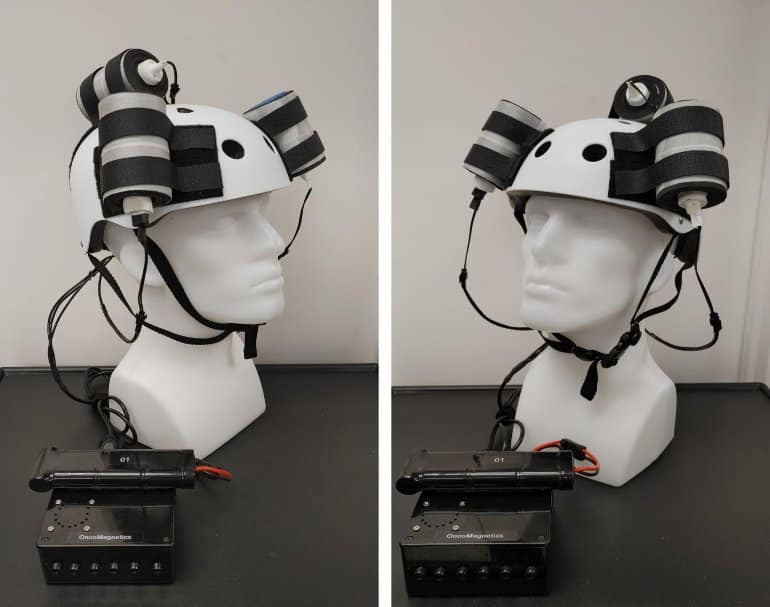Blue Origin is set to launch the New Glenn rocket to orbit. Here’s what you need to know about it.



Summary: A novel helmet that generates a noninvasive oscillating magnetic field was able to reduce tumor mass by 31% in a glioblastoma brain cancer patient.
Source: Houston Methodist.
Houston Methodist Neurological Institute researchers from the department of neurosurgery shrunk a deadly glioblastoma tumor by more than a third using a helmet generating a noninvasive oscillating magnetic field that the patient wore on his head while administering the therapy in his own home. The 53-year-old patient died from an unrelated injury about a month into the treatment, but during that short time, 31% of the tumor mass disappeared. The autopsy of his brain confirmed the rapid response to the treatment.

According to the UCS report, however, sodium-cooled fast reactors such as Natrium would likely be less uranium-efficient and would not reduce the amount of waste that requires long-term isolation. They also could experience safety problems that are not an issue for light-water reactors. Sodium coolant, for example, can burn when exposed to air or water, and the Natrium’s design could experience uncontrollable power increases that result in rapid core melting.
Unlike light-water reactors, these non-light-water designs rely on materials other than water for cooling. Some developers contend that these reactors, still in the concept stage, will solve the problems that have plagued light-water reactors and be ready for prime time by the end of this decade.
The siren song of a cheap, safe and secure nuclear reactor on the horizon has attracted the attention of Biden administration officials and some key members of Congress, who are looking for any and all ways to curb carbon emissions. But will so-called advanced reactors provide a powerful tool to combat climate change? A Union of Concerned Scientists (UCS) analysis of non-light-water reactor concepts in development suggests that outcome may be as likely as Energy Commission Chairman Lewis Strauss’ famous 1954 prediction that electricity generated by nuclear energy would ultimately become “too cheap to meter.” Written by UCS physicist Edwin Lyman, the 140-page report found that these designs are no better—and in some respects significantly worse—than the light-water reactors in operation today.
Lyman took a close look at the claims developers have been making about the three main non-light-water designs: sodium-cooled fast reactors, high-temperature gas-cooled reactors and molten salt–fueled reactors. With little hard evidence, many developers maintain they will be cheaper, safer and more secure than currently operating reactors; will burn uranium fuel more efficiently, produce less radioactive waste, and reduce the risk of nuclear proliferation; and could be commercialized relatively soon. Those claims, however, do not hold up to scrutiny.

The Koenigsegg Gemera is a four-seat hypercar that can do 0–62 mph in a claimed 1.9 seconds, but perhaps the most remarkable thing about this Swedish rocket ship is its 2.0-liter twin-turbocharged inline-3, which makes a staggering 600 horsepower (plus 443 pound-feet of torque).
Jason Fenske at Engineering Explained has the details on how Koenigsegg extracted so much power from such a small engine. It starts with the cylinders. There may not be many of them, but they are pretty big. They’re actually larger than the cylinders in Koenigsegg’s 5.0-liter V8, Fenske noted.
Koenigsegg’s new Gemera makes over 1700 horsepower, with close to a third of that figure coming from a 3-cylinder engine.
Late last year, a French company called Carmat received approval in Europe for its total artificial heart. It’s exactly what it sounds like: a heart made of synthetic and biological materials intended for implantation into people who need heart transplants. Now, just half a year later, the first US patient has received one of the hearts.
The transplant took place last week in a 39-year-old man at Duke University Hospital in North Carolina. The man didn’t go to the hospital expecting to have a heart transplant, but it ended up saving his life.
After experiencing unexpected heart failure, he was diagnosed with advanced coronary artery disease (when plaque builds up in the blood vessels that carry oxygen-rich blood to heart) and went in for bypass surgery (which implants a healthy blood vessel from another part of the body to redirect blood around a blocked artery).

Boston startup Form Energy has secured $200 million Series D funding for the development of what is being called a breakthrough in energy storage. #solarenergy #solarpv #solar
Solar and wind power have variability in their productive hours, as multi-day weather events can impact output. Therefore, multi-day storage that is cost effective is important in grid reliability.
Boston startup Form Energy developed technology to address this need, revealing recently the chemistry behind their iron-air batteries. The company said its iron-air batteries can deliver renewables-sourced electricity for 100 hours at system costs competitive with conventional power plants. At full-scale production, Form Energy said the modules would deliver electricity at tenth the cost of lithium-ion batteries.
The iron-air battery is composed of cells filled with thousands of iron pellets that are exposed to air and create rust. The oxygen is then removed, reverting the rust to iron. Controlling this process allows the battery to be charged and discharged.
Good day to you all.
Sirtuins are once again, making headlines. From a longer lifespan, again, through to helping old and dormant hair follicles to grow new hair, and of course a discourse between certain personalities on twitter, they continue to stimulate the interest and promise so much…
So I have decided to follow up my last sirtuins video with this one, Sirtuins revisited.
Here I look at them all from 1 to 7, to see what is being claimed for each one, and then I look at all the ways we can try to bring them all up to optimum so that we can live long, healthy lives, free from the maladies of old age.
I look at lifestyle interventions from exercise, saunas, cold therapies and more, through to diet choices and then finally on to supplements that are available to boost them all further.
So I hope you find it of use and enjoyable, and have a great weekend.
On July 20th, 2021 NASA’s Perseverance Mars Rover transmitted new images from Red Planet trying to collect first sample. Rover currently studying geological features of “Crater Floor Fractured Rough” area. While the rocks located in this geologic unit are not great time capsules for organics, NASA’s scientists believe they have been around since the formation of Jezero Crater and incredibly valuable to fill gaps in our geologic understanding of this region – things we’ll desperately need to know if we find life once existed on Mars. Photo of tube located in Mars rock was taken by Perseverance Rover on Sol 148.
Credit: nasa.gov, NASA/JPL-Caltech, NASA/JPL-Caltech/ASU
Source for NASA’s Perseverance Mars mission: https://mars.nasa.gov/mars2020/spacecraft/rover/
#mars #perseverance #rover

The University of Surrey has built an artificial intelligence (AI) model that identifies chemical compounds that promote healthy aging — paving the way towards pharmaceutical innovations that extend a person’s lifespan.
In a paper published by Nature Communication’s Scientific Reports, a team of chemists from Surrey built a machine learning model based on the information from the DrugAge database to predict whether a compound can extend the life of Caenorhabditis elegans — a translucent worm that shares a similar metabolism to humans. The worm’s shorter lifespan gave the researchers the opportunity to see the impact of the chemical compounds.
The AI singled out three compounds that have an 80 percent chance of increasing the lifespan of elegans:

Amazing.
While Venice may be home to the first 3D-printed concrete footbridge to be constructed entirely sans reinforcement or mortar, the similarly canal laced city of Amsterdam, not to be outdone, has unveiled the world’s first 3D-printed steel pedestrian bridge. The long-awaited project, first announced in 2015, was dedicated on the Oudezijds Achterburgwal canal in the city’s Red Light District on July 15. The ceremony was attended by Her Majesty the Queen of the Netherlands, Máxima, who was assisted by a ribbon-cutting robot during the festivities.
Spanning nearly 40 feet across the canal, the curving 6-ton stainless steel structure was constructed by Amsterdam-based 3D metal printing technology company MX3D using a wire arc additive manufacturing process that marries advanced robotics with welding. With the aid of four robots, the entire printing process took just six months. The completed bridge, designed by Joris Laarman Lab with Arup serving as lead engineer, was first unveiled in October 2018 during Dutch Design Week. Several load-testing rounds followed, the last of which was carried out in the fall of 2019 with plans to install the structure in early 2020. However, ongoing site prep work at the canal delayed the factory-produced bridge’s installation to just last week.
As reported by the Associated Press, the stainless steel structure, dubbed the MX3D Smart Bridge, will remain in place for at least two years while the footbridge that previously spanned the canal undergoes renovation.